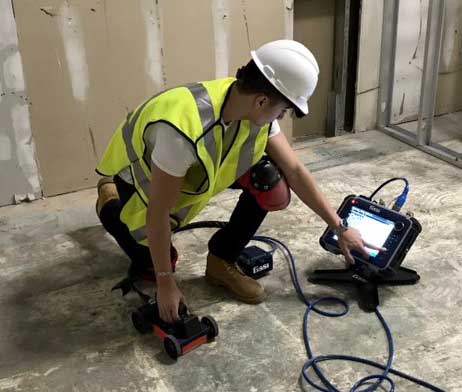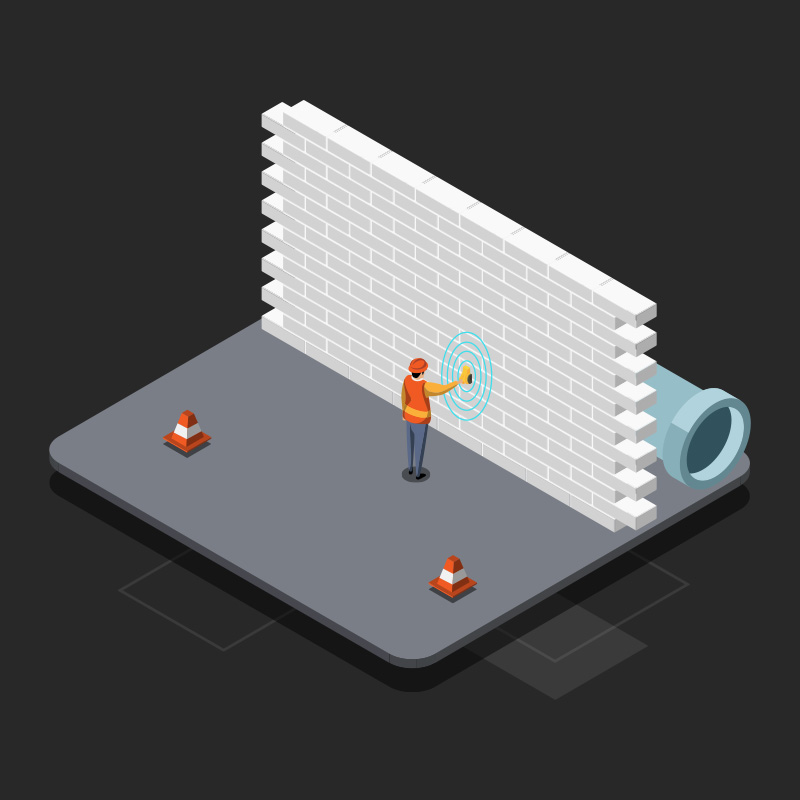Elevate Your Building Process With the Strategic Insights of Concrete Scanning for Enhanced Performance
In the realm of modern-day construction techniques, the mission for efficiency and precision is extremely important. Accepting innovative innovations has come to be a cornerstone for accomplishing these goals. One such modern technology that has reinvented the construction market is concrete scanning. By using the calculated understandings provided by concrete scanning, building specialists can unlock a realm of boosted productivity and streamlined processes. The effects of integrating concrete scanning go far beyond surface-level benefits, offering a profound influence on job end results.

Advantages of Concrete Scanning
Enhancing project efficiency and safety and security, concrete scanning offers a non-destructive method for discovering surprise objects within concrete structures. By making use of technologies such as ground-penetrating radar (GPR) and concrete x-ray imaging, construction teams can properly find rebar, post-tension cables, electrical conduits, and various other obstructions before drilling, cutting, or coring right into concrete.
The advantages of concrete scanning are countless. It decreases the risk of unintentional damage to crucial structural components, decreasing the chance of costly fixings and job hold-ups. It enhances employee safety and security by supplying real-time understandings right into the location of surprise risks - Concrete Scanning. Building websites can be complex settings, and knowing what exists underneath the surface can stop injuries and mishaps.
In addition, concrete scanning promotes overall task performance by enhancing workflows and protecting against rework. By identifying potential concerns early, groups can readjust their plans proactively, saving time and resources in the future. Essentially, the fostering of concrete scanning modern technologies is a strategic investment that pays returns in regards to cost-effectiveness, safety and security, and performance.
Technology Assimilation for Efficiency
Concrete scanning's capacity to streamline operations and improve task efficiency can be additional maximized via critical combination of advanced technologies. By incorporating Structure Information Modeling (BIM) software application into concrete scanning processes, building groups can achieve a greater degree of accuracy and control. In addition, the combination of Increased Reality (AR) technology with concrete scanning can boost on-site visualization, enabling job supervisors and employees to overlay electronic details onto the physical atmosphere in genuine time.
Preventing Expensive Errors
Exactly how can careful focus to information throughout concrete scanning processes assist building teams in stopping costly errors? Concrete scanning plays an essential role in identifying prospective problems before they intensify into expensive errors. By making use of innovative scanning modern technologies such as Ground Passing Through Radar (GPR) and electromagnetic induction, construction teams can accurately discover rebar, energies, gaps, and other obstructions within concrete structures. This degree of accuracy makes it possible for task supervisors to make informed decisions concerning the layout and layout of their construction plans, reducing the risk of unintended damage to critical infrastructure throughout the building process. Additionally, concrete scanning aids in making certain architectural stability by recognizing weaknesses or problems in the concrete beforehand, allowing for prompt repair work and modifications. By proactively dealing with these concerns, construction groups can prevent costly mistakes such as rework, delays, or safety dangers that may emerge from forgotten disparities in the concrete structure. Inevitably, purchasing extensive concrete scanning procedures confirms to be a cost-efficient method in the future, conserving both time and sources while enhancing total project performance and high quality.
Enhancing Job Management
Precise interest to information throughout concrete scanning processes not just helps in preventing pricey errors however likewise lays a strong foundation for reliable task management in building endeavors. By including concrete scanning innovation into project management approaches, building groups can enhance process, improve communication, and ensure that projects remain on track.
Concrete scanning provides valuable understandings right into the structural stability of existing aspects, enabling project managers to make enlightened choices concerning design modifications or building series. This positive method reduces the threat of unexpected hold-ups or remodel, eventually saving time and resources. Furthermore, the data obtained from concrete scanning can be incorporated into Building Details Modeling (BIM) platforms, enabling real-time collaboration and control amongst different stakeholders.
Additionally, concrete scanning helps job supervisors determine potential threats or challenges prior to they rise into larger concerns, advertising a more secure work environment for all entailed. With enhanced visibility and accuracy click reference given by concrete scanning innovation, task supervisors can effectively prepare, keep track of, and execute construction tasks with greater performance and confidence.
Maximizing Performance
One vital facet of making the most of efficiency is via the fostering useful source of concrete scanning technology. By making use of ground-penetrating radar (GPR) and other scanning methods, building groups can precisely situate rebar, avenues, and various other subsurface components, lessening the risk of pricey mistakes and delays during excavation and drilling.
Moreover, accepting Building Details Modeling (BIM) software program can substantially boost productivity by developing comprehensive 3D designs that improve project visualization and coordination among different trades. BIM enables far better clash detection, allowing issues to be determined and fixed before building even starts, conserving time and resources over time.
Implementing a lean construction strategy, which concentrates on getting rid of waste and optimizing efficiency throughout all task phases, is one more efficient technique for maximizing performance. By cultivating partnership, interaction, and constant renovation, construction groups can work extra cohesively towards accomplishing job goals in a effective and streamlined fashion.
Conclusion
Finally, the critical implementation of concrete scanning in the construction process offers various benefits, including boosted efficiency, price financial savings, boosted project monitoring, and enhanced performance. By incorporating this innovation, construction teams can avoid pricey mistakes, streamline their procedures, and maximize their total project output. Concrete scanning is a valuable tool that can raise the building and construction procedure and lead to more lucrative and successful results.
